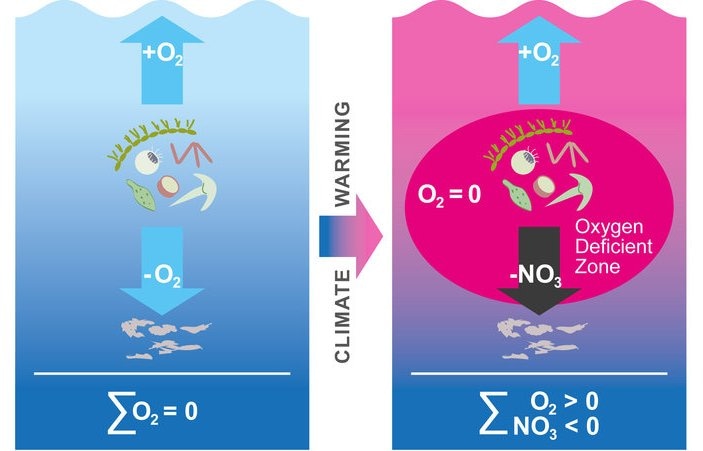Jun 28 2019
With the increase in temperature, gases dissolved in the water reduce—this simple physical relationship describes, among other things, the quantifiable loss of oxygen in the warming ocean.
 Currently, organic material in the ocean is mainly degraded with oxygen (left). Together with a warming of the ocean this leads to deoxygenation. In a future, warmer ocean (right), more organic material is respirated by denitrification with nitrate. The associated oxygen saving would even exceed the oxygen loss due to warming. (Image credit: Rita Erven/GEOMAR)
Currently, organic material in the ocean is mainly degraded with oxygen (left). Together with a warming of the ocean this leads to deoxygenation. In a future, warmer ocean (right), more organic material is respirated by denitrification with nitrate. The associated oxygen saving would even exceed the oxygen loss due to warming. (Image credit: Rita Erven/GEOMAR)
However, researchers at the GEOMAR Helmholtz Centre for Ocean Research Kiel have reported a model study in the Nature Communications, an international journal, that proposes that, in spite of warming and centuries of deoxygenation, the ocean will have more oxygen in 4,000 years than at present. The study not only reveals inconsistencies in the oxygen budget of earlier simulations but also raises new questions.
Several studies based on direct measurements in recent years have shown that the oxygen content in the oceans decreasing. As water can dissolve a small amount of gas with increased temperatures, these outcomes were not astonishing.
Besides global warming, factors such as eutrophication of the coastal seas are also responsible for the ongoing deoxygenation. Will the oceans become fully oxygen-depleted at some point in time if global warming persists? These anoxic phases, together with crucial mass extinction events, have indeed occurred many times in the history of Earth, followed by the increased concentrations of CO2 in the atmosphere and increased global temperatures.
At present, researchers from the GEOMAR Helmholtz Centre for Ocean Research Kiel have reported model simulations on the increase in the oxygen content of the oceans up to year 8000 in the international journal, Nature Communications.
In their development, the researchers assumed that a major portion of the fossil resources will be burnt and that emissions will continue to increase until the close of the century and later will decrease to zero by the year 2300. The Earth, in the model, gets heated up by a further 6 °C, and temperatures will continue to be at this high level until the end of the simulation.
The amazing finding concerns the ocean’s oxygen content: After an additional decrease over several centuries, the oxygen inventory of the ocean increases again and also reaches a higher level than before industrialization in just below 4,000 years.
It may seemingly appear paradoxical that in spite of the anticipated further expansion of the already existing oxygen minimum zones in the oceans across the world, the model produces a sudden increase in oxygen with the increase in global temperatures.
The research of the Kiel Collaborative Research Centre 754 reveals that the areas poor in oxygen are death zones for huge organisms such as cephalopods or fish. However, certain bacteria that inhales nitrate rather than oxygen easily grow there.
They draw their energy from a chemical process we call denitrification. It is an important component of the nitrogen cycle, that results in less oxygen being consumed during respiration of organic material than that produced during photosynthesis.
Andreas Oschlies, Professor, GEOMAR Helmholtz Centre for Ocean Research Kiel
For the first time, the scientists in the new model simulation, have combined the oxygen cycle with the nitrogen cycle in long-lasting global simulations in a consistent manner. Due to the lasting oxygen minimum zones, the scientists discovered that an increasing amount of organic material is not breathing oxygen but nitrate by means of denitrification. Following several thousand years, the related oxygen savings exceeded the oceans’ oxygen loss due to warming.
However, we cannot speak of a recovery, since the extensive oxygen minimum zones near the sea surface would stay. A large part of the additional oxygen goes into the deep ocean.
Angela Landolfi, Study Co-Author, GEOMAR Helmholtz Centre for Ocean Research Kiel
But there is a new issue: It is not easy to explain the anoxic phases that have occurred in Earth’s history during warm climatic conditions with the new findings. It is clear that factors and feedback processes in the complicated interactions of physical, biological, and chemical processes in the ocean are not yet completely understood.
Andreas Oschlies outlines the importance of the study, stating that, “This is why the study is also important for the present. It points to knowledge gaps, such as the interaction of denitrification and nitrogen fixation, that can also be relevant for ongoing ocean changes.”